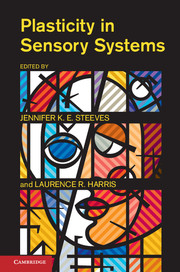Book contents
- Frontmatter
- Contents
- List of Contributors
- 1 Plasticity in Sensory Systems
- I VISUAL AND VISUOMOTOR PLASTICITY
- II PLASTICITY IN CHILDHOOD
- III PLASTICITY IN ADULTHOOD AND VISION REHABILITATION
- 9 Visual Plasticity of the Adult Brain
- 10 Beyond the Critical Period: Acquiring Stereopsis in Adulthood
- 11 Plasticity and Restoration after Visual System Damage: Clinical Applications of the “Residual Vision Activation Theory”
- 12 Applying Plasticity to Visual Rehabilitation in Adulthood
- Author Index
- Subject Index
- References
10 - Beyond the Critical Period: Acquiring Stereopsis in Adulthood
from III - PLASTICITY IN ADULTHOOD AND VISION REHABILITATION
Published online by Cambridge University Press: 05 January 2013
- Frontmatter
- Contents
- List of Contributors
- 1 Plasticity in Sensory Systems
- I VISUAL AND VISUOMOTOR PLASTICITY
- II PLASTICITY IN CHILDHOOD
- III PLASTICITY IN ADULTHOOD AND VISION REHABILITATION
- 9 Visual Plasticity of the Adult Brain
- 10 Beyond the Critical Period: Acquiring Stereopsis in Adulthood
- 11 Plasticity and Restoration after Visual System Damage: Clinical Applications of the “Residual Vision Activation Theory”
- 12 Applying Plasticity to Visual Rehabilitation in Adulthood
- Author Index
- Subject Index
- References
Summary
When I was 48 years old, my vision improved in ways that most scientists and physicians considered impossible (Barry, 2009; Sacks 2006, 2010). I had developed strabismus, or misaligned eyes, within the first months of life. When I looked at an object, I aimed or fixated one eye at the target and turned the other eye in. In contrast, most infants aim their eyes simultaneously at the same point in space and are able to fuse the two eyes' images into one view of the world. They develop stereopsis, or the ability to use the slightly different viewing perspectives of the two eyes to create the perception of stereoscopic depth. Because I aimed my eyes at different regions of space, I received uncorrelated images that could not be fused. How could I create a single worldview from the conflicting input from my two eyes? Like most children with strabismus, I learned to ignore or suppress the input from the turned eye. This provided me with a single view of the world but one that lacked stereoscopic depth. I did not see with stereopsis: I was stereoblind.
In an attempt to correct this condition, I underwent three eye muscle surgeries at the ages of 2, 3, and 7 years. The operations helped my eyes to look straight but did not change my viewing habits. I continued to fixate with one eye and turn in the other, rapidly alternating between the eye that I used for fixation and the eye that I turned in.
- Type
- Chapter
- Information
- Plasticity in Sensory Systems , pp. 175 - 195Publisher: Cambridge University PressPrint publication year: 2012



